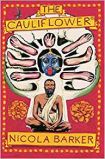The Cauliflower® by Nicola Barker
| The Cauliflower® by Nicola Barker | |
|
| |
| Category: Literary Fiction | |
| Reviewer: Rebecca Foster | |
| Summary: Put simply, this is a fictionalized biography of the Hindu guru Sri Ramakrishna. That may sound dry as dust, but Barker makes it a playful delight by skipping around in time and interspersing aphorisms, imagined film scenes, poems, questions and answers, and even a recipe with the narrative chapters. Bizarre but very readable; this novel is recommended. | |
| Buy? Yes | Borrow? Yes |
| Pages: 336 | Date: April 2016 |
| Publisher: William Heinemann | |
| ISBN: 9781785150661 | |
| Video:
| |
Nicola Barker teasingly refers to herself as this book's 'collagist', piecing together diverse documents to create a picture of Sri Ramakrishna (1836–1886), a largely illiterate guru who attracted followers to his intense worship of the goddess Kali. His life story is a sticky mass of contradictions:
Oh which of us can truly comprehend the divine play of Sri Ramakrishna? Is he man or child? Leader or follower? Masculine or feminine? Radical or conservative? Idiot or genius? A god, a god-man or just too, too human? Is this book a farce, a comedy, a tragedy or a melodrama?
The kernel of the story – set in 1857 at the Dakshineswar Kali Temple, six miles north of Calcutta – is narrated in the first person by the guru's nephew, Hriday. No matter how wildly it swings, the narrative keeps returning to this stable point. Hriday takes seriously his duty to guard the guru's legacy: 'Uncle's past…needs to be stage-managed and well-lit. I am Uncle's technician.' Barker sometimes takes that idea of stage managing literally, inserting director's cues, documenting conversations in the form of theatrical dialogue, and describing the 'filming' of scenes. In the most imaginative chapter of all, she leads readers on a bird's-eye tour of the temple complex by attaching a camera to a swift in 1855. A less daring writer might have bored readers stiff with several pages of architectural detail instead.
The secondary characters in orbit around Sri Ramakrishna include Rani Rashmoni, the headstrong widow who founded the temple and weathered a storm of controversy over serving cooked food to pilgrims; Mathur Baba, the son-in-law who takes over after her death; the guru's wife Sarada (their relationship is never consummated); a mysterious brahmini who comes to train the guru in Tantra; and various scribes and devotees.
All of these, however, pale in comparison to the guru himself, who takes on mythical proportions. He embarrasses Hriday and sometimes suffers physical injury due to his frequent, sudden lapses into ecstasy. With his immaculate conception, his preaching against the love of money and lust, his sayings about 'God's kingdom', and the idea that his pain and suffering might expiate others' sins, there is more than a hint of similarity with Jesus. However, Barker notes that Sri Ramakrishna's message was apolitical, unlike, say, Mother Teresa's; he was fully dedicated to the pursuit of God and paid little heed to human suffering.
Scripture of all types (the Bible is also cited and alluded to) is a relevant, joyful echo here rather than a dull set of rules. Some of the guru's teachings are delivered as pithy three-line stanzas, almost like haikus:
Live like the mudfish –
Even though it dwells in filth
Its skin stays spotless.
Misery is good!
If the whole world was happy
Who would chant God's name?
It's good to question!
Scepticism is a path
To realise God.
There's a good balance between short passages like those – set out on their own page, surrounded by lots of blank space – and longer historical chapters. For the most part I enjoyed Barker's mix of formats, especially a list of 'Twelve slightly impertinent questions about Ma Kali' and a fragmentary anthropologist's report. However, in places the diversions don't seem altogether germane (like potted histories of some of the guru's devotees) and come across as a little indulgent.
In a short afterword Barker reveals that she has been fascinated by the story of Sri Ramakrishna since age 10, when she was given a free Krishna Consciousness album while walking through the Oriental Plaza in Fordsburg, South Africa. She offers a comprehensive bibliography of related books and other media for keen readers to continue with. An interest in world religions would certainly be a boon for someone picking up this novel, but you can also enjoy it as an intriguing exploration of new strategies for telling the story of a life.
Many novels set in India are epics in terms of both scope and length. Barker, on the other hand, has managed to take vast amounts of information – the development of Calcutta, the Hindu traditions surrounding Kali, and the cult that grew up around Sri Ramakrishna and his teachings – and pare it all down into something 'deliciously condensed, like a sweet, biographical mango compote'.
Best of all, it's good fun. Case in point: you may be wondering about the unusual title. It relates to an incident when an English visitor brought the guru a cauliflower as a gift and Hriday angrily rejected it because of the explosive flatulence it creates for poor Uncle. You know you're in good hands if an author can tell an embarrassing story about a venerated figure yet still convey deep respect. Bizarre but very readable; this novel is recommended.
Further reading suggestion: To appreciate the wide range of her talent, fans should read Burley Cross Postbox Theft. If you want to learn more about Hinduism you might also try Brahma Dreaming: Legends from Hindu Mythology by John Jackson and Daniela Jaglenka Terrazzini.
Please share on: ![]() Facebook,
Facebook, ![]() Twitter and
Twitter and
![]() Instagram
Instagram
![]() You can read more book reviews or buy The Cauliflower® by Nicola Barker at Amazon.co.uk Amazon currently charges £2.99 for standard delivery for orders under £20, over which delivery is free. (Paid link)
You can read more book reviews or buy The Cauliflower® by Nicola Barker at Amazon.co.uk Amazon currently charges £2.99 for standard delivery for orders under £20, over which delivery is free. (Paid link)
![]() You can read more book reviews or buy The Cauliflower® by Nicola Barker at Amazon.com. (Paid link)
You can read more book reviews or buy The Cauliflower® by Nicola Barker at Amazon.com. (Paid link)
Comments
Like to comment on this review?
Just send us an email and we'll put the best up on the site.


